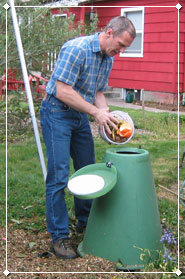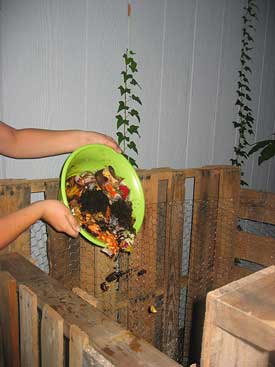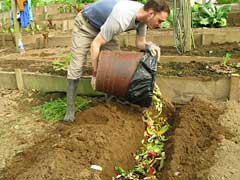
Professor Rot says:
Compostable food scraps are one of the best and readily available sources of organic materials for home composting.
In fact, you're a fool to not compost your food waste! What better way to return to the Earth than to recycle your food waste in your own yard!
|
Composting food scraps at home is one of the most important aspects of home composting. Why? Because food scrap items such as vegetable and fruit waste, meal leftovers, coffee grounds, tea bags, stale bread, grains, and general refrigerator spoilage are an everyday occurrence in most households.
One of the "great waves" in municipal and home recycling is the concentration on what to do with the enormous amount of food waste generated in and out of the home, by businesses, or as a result of surplus farming. On the grand scale, it is estimated that about one-half of all food that is produced or consumed in the U.S. is discarded. The main culprits are spoilage and overproduction/surplus.
 A typical household throws away an estimated 474 pounds of food waste each year. Put another way, that is about 1.5 lbs per person a day in the U.S. Food scraps generated by all households in the United States could be piled on a football field more than five miles (26,400 feet) high! A typical household throws away an estimated 474 pounds of food waste each year. Put another way, that is about 1.5 lbs per person a day in the U.S. Food scraps generated by all households in the United States could be piled on a football field more than five miles (26,400 feet) high!
Up to 90 percent of waste thrown out by businesses like supermarkets and restaurants is food scraps. In fact, food scraps are the third largest segment of the waste stream with nearly 26 million tons generated each year. Of the overall wastestream, about 12% is food-related, behind paper and plastic.
CHECK WITH YOUR MUNICIPAL WASTE MANAGEMENT DISTRICT TO SEE IF YOU ARE ALLOWED TO COMPOST FOOD SCRAPS AT HOME!
 Believe it or not, some cities have issues with the home composting of food scraps. Why? Because there is the concern over attracting rodents and other vermin (racoons, opossums, scavengers, etc.) to an inadequately secure compost bin. Therefore, a community may desire more control over food waste recycling. Believe it or not, some cities have issues with the home composting of food scraps. Why? Because there is the concern over attracting rodents and other vermin (racoons, opossums, scavengers, etc.) to an inadequately secure compost bin. Therefore, a community may desire more control over food waste recycling.
Some communities are exploring curbside food waste disposal, using specially designed receptacles. They believe they can control the food wastestream better. Unfortunately, such food disposal has a flaw, from our perspective. Very often, food waste that should not be composted (see chart below) is comingled with appropriate compostable food scraps.
WHAT HOME FOOD WASTE CAN YOU COMPOST?
Not all food waste is created equal. You should know this or else you may have problems popping up in your compost bin or pile. BIG PROBLEMS! Actually, once you look at the chart below, commonsense will be your guide.
DO COMPOST |
DON'T COMPOST |
- All your vegetable and fruit wastes, (including rinds and cores) even if they are moldy and ugly
- Old bread, donuts, cookies, crackers, pizza crust, noodles: anything made out of flour!
- Grains (cooked or uncooked): rice, barley, you name it
- Coffee grounds, tea bags, filters
- Fruit or vegetable pulp from juicing
- Old spices
- Outdated boxed foods from the pantry
- Egg shells (crush well)
- Corn cobs and husks (cobs breakdown very slowly)
|
- Meat or meat waste, such as bones, fat, gristle, skin, etc.
- Fish or fish waste
- Dairy products, such as cheese, butter, cottage cheese, yogurt, cream cheese, sour cream, etc.
- Grease and oils of any kind
Why can't you compost
these food wastes?
- They inbalance the otherwise nutrient-rich structure of other food and vegetation waste and breakdown slowly
- They attract rodents and other scavenging animals
- Meat attracts maggots
- Your compost bin will smell to holy hell and back!
|
CREATE A HOME FOOD WASTE PLAN!
 Now that you know what you can compost out of your kitchen, create a household plan. Use this plan from food preparation and storage to kitchen storage, and ultimately to the compost bin. Now that you know what you can compost out of your kitchen, create a household plan. Use this plan from food preparation and storage to kitchen storage, and ultimately to the compost bin.
Food Scraps at the Stove
Ever wonder how those sauces or soups at your favorite restaurant are prepared? Yes, from vegetable scraps such as peels, skins, stalks, etc.  Simply simmer a small pan of such scraps, as seen on the front burner in the photograph, for a few hours, let cool, then store in your refrigerator until you desire to make a soup or sauce. The stock is delicious, and you did a little vegie recycling to boot! Simply simmer a small pan of such scraps, as seen on the front burner in the photograph, for a few hours, let cool, then store in your refrigerator until you desire to make a soup or sauce. The stock is delicious, and you did a little vegie recycling to boot!
How to Store Compostable Food Scraps
Many people who have an in-sink garbage disposal don't even consider this fact: what they grind up ends up merging with the wastestream leaving their house and into the larger wastestream of their municipality. This definitely taxes municapl waste treatment facilties. Home composting is a decision to have the buck stop at your household.
- Scraps can be stored in plastic bags in your refrigerator until used in your compost bin
- Scraps can take up less space if you chop or shred them first during meal preparation
- Scraps can be stored in a Kitchen Compost Pail until taken to your compost bin
The KITCHEN COMPOST PAIL
 The best way to store food scraps until thrown into the compost bin is in a securely lidded Kitchen Compost Pail. This can be kept near the sink or beneath it. See photograph. The best way to store food scraps until thrown into the compost bin is in a securely lidded Kitchen Compost Pail. This can be kept near the sink or beneath it. See photograph.
You can purchase a food scrap pail designed specifically to securely store food scraps. Look for one with a tight-fitting lid, adequate storage, aesthetic appeal, washable, and with a handle. You can also use a plastic container, such as a 1-quart yogurt container for small quantities of scraps.
Empty your containers daily or every few days, depending upon how much waste you generate, or to insure that no smell starts permeating the kitchen or home. You can always cover the scraps inside a container with a wet paper towel or newspaper to cut down on odor or gnats.
You can decide to empty your kitchen food scrap pail directly into your compost bin. This method is known as the Add-as-You-Go Pile, as thoroughly described on this website. Better yet is to use a 4-5 gallon lidded bucket to stockpile food scraps, as detailed below.
The FOOD SCRAP BUCKET
A Food Scrap Bucket is simple to locate. Just look for a 4-5 gallon bucket at your local hardware store. Some food establishments or wholesalers have some as well.
Keep the bucket near your backdoor or compost bin. |
|
A good way to keep fruit flies or gnats from sneaking into the bucket is to line the lid with newspaper. This also cuts down on odors seeping out.
Replace the paper when it gets moist and deteriorates. |
 |
Pour the contents of your Kitchen Compost Pail into the Food Scrap Bucket.
How simple can it be!
Wash your Kitchen Pail well to use again. |
 |
Here's a good trick to cut down on odors or potential fruit flies or gnats:
Have nearby a small pail of finished compost, peat moss, sawdust, rock dust, leaf mulch or humus (good soil). |
 |
Then, scoop a trowel full of the material and sprinkle it on the top of the newly-added food scraps.
A sure fire way to help the food scraps to breakdown, because of the addition of BROWNs to the GREENs of the food scraps. |
 |
 Pick Your Problem: Pick Your Problem:
ODOR? FLIES? RODENTS?
The cause is always AT LEAST ONE of these:
- Did you add one of the DON'Ts to your pile? Remove them and don't do it again, ever! Never! Or else!
- Did you DUMP-AND-RUN: quickly disposed of food scraps on the top of your pile? Please take a moment each time to cover them with a small layer of brown materials (leaves, sawdust, compost, soil, activator)
- Have you turned or intermixed the GREEN & BROWN ingredients of your pile lately? Please do so joyfully!
|
OTHER WAYS TO COMPOST FOOD SCRAPS
 |
The Green Cone Composter
This small compost bin is touted to be able to compost any form of food scrap, including the DON'Ts such as meat, fats, etc. How?
The manufacturer purports that inside its sealed container (notice no air vents), a tremendous amount of heat builds up to quickly decompose the material.
It's worth considering. Is used a lot in other countries. www.greencone.com |
|
Soil Incorporation
(Trench Composting)
The premise is simple: BURY your food waste (and yard waste), if allowed in your municipality.
Just dig a trench about 12-inches deep (30cm), throw in the items, chop and mix with soil, then cover with remaining soil. In a few months the rotted material will have been incorporated into the soil and you can plant above them. |
 |
Raised-Bed Garden Integration
Similar to Soil Incorporation. Just dump the food scraps into the raised-bed and dig them into the soil deeply so that no scavengers can get to them.
In no time the worms will have digested every last bit of the food you wasted! |
 |
Add-as-You-Go Compost Pile
Here you just throw in on top your compost pile and get on with your life.
Oh, but wait a minute. Don't you want to cover it with some BROWN layer to keep the fruit flies and gnats and rodents and other creatures away?
In this picture, the bin is made out of pallets. The problem is that the bin is easily accessible by rodents who wiggle through the chicken-wire and the gaps in the wooden sides.
Also, it is a huge bin and it will take an immense volume of waste to heat up, if it ever does! |
|



 A typical household throws away an estimated 474 pounds of food waste each year. Put another way, that is about 1.5 lbs per person a day in the U.S. Food scraps generated by all households in the United States could be piled on a football field more than five miles (26,400 feet) high!
A typical household throws away an estimated 474 pounds of food waste each year. Put another way, that is about 1.5 lbs per person a day in the U.S. Food scraps generated by all households in the United States could be piled on a football field more than five miles (26,400 feet) high!  Believe it or not, some cities have issues with the home composting of food scraps. Why? Because there is the concern over attracting rodents and other vermin (racoons, opossums, scavengers, etc.) to an inadequately secure compost bin. Therefore, a community may desire more control over food waste recycling.
Believe it or not, some cities have issues with the home composting of food scraps. Why? Because there is the concern over attracting rodents and other vermin (racoons, opossums, scavengers, etc.) to an inadequately secure compost bin. Therefore, a community may desire more control over food waste recycling. Now that you know what you can compost out of your kitchen, create a household plan. Use this plan from food preparation and storage to kitchen storage, and ultimately to the compost bin.
Now that you know what you can compost out of your kitchen, create a household plan. Use this plan from food preparation and storage to kitchen storage, and ultimately to the compost bin. Simply simmer a small pan of such scraps, as seen on the front burner in the photograph, for a few hours, let cool, then store in your refrigerator until you desire to make a soup or sauce. The stock is delicious, and you did a little vegie recycling to boot!
Simply simmer a small pan of such scraps, as seen on the front burner in the photograph, for a few hours, let cool, then store in your refrigerator until you desire to make a soup or sauce. The stock is delicious, and you did a little vegie recycling to boot! The best way to store food scraps until thrown into the compost bin is in a securely lidded Kitchen Compost Pail. This can be kept near the sink or beneath it. See photograph.
The best way to store food scraps until thrown into the compost bin is in a securely lidded Kitchen Compost Pail. This can be kept near the sink or beneath it. See photograph.









